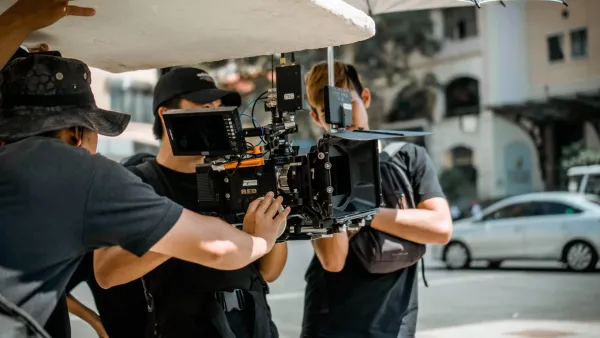The World Behind the Screen: Building Stories Through Space

By Birgul T.
Space is the most important determinant of the concept of time. It is hardly possible for us to make sense of the concept of time without space. While space is so determinant in real life, the concept of space carries great importance in cinema. Space in cinema consists of the combination of real or studio-created spaces within a narrative framework.
The power of narrative in cinema is not limited to dialogue and acting alone; space is the silent but powerful language of narrative. The spaces in which characters exist, move, and even reflect their emotions determine the soul of the story. When we enter a scene, the first thing we often feel is the atmosphere of that place. For example, a dark basement, a seaside town bathed in light, or a modern house surrounded by huge windows... All these spaces not only serve as background to the narrative but also guide the story alongside the characters.
Particularly in recent years, cinema has managed to create atmospheres that draw the audience in by displaying more creative and conscious approaches to the use of space. Cinema and space are mutually interactive as a field and tool of economic, political, cultural, social, ideological, and similar power and struggle relations.
The Role of Space in Narrative
Space in cinema is not merely the place where events occur; it is also an important narrative tool that guides the story, deepens characters, and establishes connections with the audience. A well-chosen space can reflect a character's inner world while also shaping the audience's feelings about the scene. For example, empty and vast areas that evoke loneliness or a claustrophobic apartment facilitate the audience's identification with the character.
Space works together with time to determine the rhythm of the narrative. Wide and open spaces evoke a sense of freedom, while narrow and enclosed spaces can create tension and pressure. At the same time, space can also undertake supportive functions for the plot. For example, in a murder story, an old, dark mansion used both strengthens the atmosphere and subconsciously gives clues to the audience.
Furthermore, the character's relationship with space is frequently used to reflect their state of mind and development. A character's adaptation to a house, inability to break away from that house, or constant relocation gives important signals about their psychological journey. In this way, space becomes a reflection of the character and deepens the psychological layers of the narrative.
Use of Space According to Genres
Different film genres use space for different purposes, and each genre's narrative language is strengthened through chosen spaces. Particularly in terms of atmosphere creation and emotional connection with the audience, the harmony between space and genre is of great importance.
Horror cinema is perhaps the most striking genre in terms of space usage. Spaces like isolated houses, abandoned hospitals, or the depths of forests reinforce the feeling of the unknown and threat. The operating room in the film "Do No Harm" reflects helplessness spatially while accompanying the character's step-by-step revenge and fear with its empty and cold atmosphere.
Science fiction films frequently use original and abstract spaces to reflect the future, technology, or alternative realities. The military base in the film "Rise" strengthens the narrative of future robot soldiers' uncontrollable domination over humans. In this genre, spaces are not only physical environments but also carry criticism of social order and human-nature relationships.
In romantic films, space often consists of elegant and carefully chosen areas that reflect the characters' emotional states. Environments like Parisian streets, a seaside town, or a nostalgic café invite the audience into a romantic emotional world. Sometimes they even form the basis for a fantastic romantic story like the cave in "The Lovers."
In thriller and crime films, the limitation of space draws attention. In productions taking place in single or limited environments like in the film "Anomaly," the narrowing or color of space increases the intensity of the narrative and strengthens the feeling of tension in the audience.
These genre differences reveal how functionally and creatively space can be used as a tool in cinema.
Non-Narrative (Semiotic) Meanings of Space
Space in the cinema is not only a physical area but also a powerful symbolic tool. Directors use spaces not only as places where events occur but also to express specific thoughts, emotions, or social criticisms. In this way, space becomes part of film language and offers multi-layered meanings to the audience.
For example, the houses in Bong Joon-ho's "Parasite" symbolize class discrimination. A clear visual and semantic contrast is established between the modern, spacious, and light-filled house of the wealthy Park family and the damp, dark house of the Kim family in the basement. This spatial separation represents not only the characters' social status but also their worldview and lifestyle.
Spaces can also symbolize a character's state of mind. In the film "Paranoia," the narrowness on the train, the limited movement space, is like an extension of fear and mental collapse. That feeling of helplessness on the train, the colors and order of the environment, visually reflect the character's psychology.
Color usage also appears as part of spatial semiotics. Cool tones can represent emotional distance and loneliness, while warm tones can represent intimacy or danger. Similarly, light-shadow play also increases the semantic power of space. The dark, shadowy side streets frequently seen in film noir symbolize the blurriness of justice, trust, or morality.
Through this semiotic usage, space communicates with the audience's subconscious, strengthening the film's subtext. Thus, even a single visual composition can carry numerous cultural, psychological, and sociological layers of meaning.
Space Design and Visual Narrative
Space in cinema is not only a natural or ready-made environment; it is often created through conscious aesthetic choice. Production designers, art directors, and cinematographers carefully construct every detail of space to determine the emotional tone and narrative function of a scene. Therefore, a film's space design is one of the fundamental building blocks of visual narrative.
Some directors make space design almost like a signature. Wes Anderson is known for his symmetrical compositions, pastel color palettes, and meticulously arranged interior spaces. In his films, each space is not only a background where characters are placed but also "characters" that determine the rhythm and emotional tone of the narrative. Sometimes in some narratives, space even takes the place of a character.
Similarly, the gothic structures, exaggerated perspectives, and dark atmosphere in Tim Burton films visually express the characters' introverted mental states, disconnected from the outside world. In Burton's world, space carries an almost fairy-tale-like surrealism, thus giving the narrative its own unique style.
Production design carries not only aesthetic but also a practical function. Scene transitions, a character's movement within a space, or connections between spaces increase the audience's spatial awareness. This enables the audience to follow the story without getting lost between scenes.
Therefore, space design is used not only to present beautiful images but also to interact with the audience's subconscious perception, establish emotional connections, and visually deepen the narrative.
Film Recommendations with Different Space Examples
Paranoia is one of the current and intense animated short films on Cineshort. Its duration is around three minutes, an impressive film. Both in connection with the film and in general, each of us is intensely affected by various negativities experienced in the world and our country. Written-visual media and social media bring negative and even traumatic events that we would encounter in our normal life in a day before us, and leave us helpless against events we cannot overcome and can do nothing about. Since we are constantly exposed to these news, we fall into what Gerbner described as the "Mean World Syndrome." We perceive the world as more unsafe than it actually is and become afraid. Sometimes we even expect evil from the most irrelevant people. Paranoia is a beautiful animation with deep messages. I definitely recommend the film to all of you.
Do No Harm is a beautiful short film that you will watch with interest, both emotionally and action-packed. Especially if you have a special interest in Far Eastern martial arts and like action, I can say it's perfect for you. A mother and a doctor. What should you do if your patient is both your blackmailer and your patient? The film conveys pedophilia and child trafficking, which is a really big problem in the world, with a very impressive intensity. It draws you into the film and puts you in a dilemma. My only small criticism at this point is that there are too many bloody scenes. But I think this may have bothered me as a personal preference. It's a very good film for those interested.
Anomaly is a wonderful thriller short film that you will watch with curiosity. Our hero is a mother who complains about her child's aggressiveness and receives complaints about this. Such an incident happens again at school, and afterwards they start trying various treatment methods on the child. The film is quite impressive and directly questions your own methods. Unfortunately, there is no place for differences in the modern world. We are all imprisoned within a standard determined as "normal." Behaviors perceived as slightly different are characterized as abnormal. Especially when we do this to our children even more mercilessly and try to standardize all their differences in order to raise them according to norms, that is, "normal." Our expectations are very high and our children have to fulfill them. I definitely recommend the film, hoping to develop awareness of approaching others by being aware of differences.
The Lovers is a quite melancholic fantasy & drama short film that you can only watch on Cineshort. Actually, it's exactly a story of "the one left behind." It's like the answer to the question of whether separation is harder for the one who leaves or the one who stays. Our hero Teresa, with all her pure feelings, waits for the return of her husband who disappeared after a fishing trip. She reaches such a state that people begin to doubt Teresa's sanity and she becomes the subject of mockery for all children. The missing husband's brother is also the mayor of the town and has banned everyone in town from entering the sea after his brother's disappearance at sea. He claims there is a monster in the sea. Teresa has an accident and is rescued along with a giant fish. The mayor, believing that the monster is this fish, kills the fish and lifts the ban accompanied by a festival, but events begin after that. A reunion takes place, but revenge is also taken properly. I definitely recommend this film with its quite interesting and equally melancholic story to everyone. Enjoy watching.
Rise is a wonderful science fiction short film you will watch with excitement. Our hero is a robot that has achieved consciousness. They engage in a war with the human race. The conversation with the colonel who captures the robot is actually a confrontation. I think the work done on technological devices and artificial intelligence is very important. We may definitely need developments that will make our lives easier and take us to a higher level, ensuring social peace. But there are also points I'm worried about. One is actually the correctness and morality of the things we try to teach artificial intelligence, which overlaps with the subject in the film. According to what will these be determined? Another issue is whether destroying that robot would be considered murder if consciousness is achieved? Or will the robot be included in the punishment system? Actually, what I mean is this: technological developments are happening faster than we think, but are we humans ready for this with all our systems, structures, applications, and moral development level? I have reservations about this. Returning to the film, I definitely recommend the film.
Flocky is a wonderful animated short film that you can only watch on Cineshort. I must definitely say it's one of the best animations I've watched in a long time. It contains quite emotional elements. A mother, whether her baby is born alive or dead, always carries that special state that motherhood has given her. We have a mother who learns she will have a baby, and a very special bond forms between her and her baby. Spending time with him is a wonderful feeling. They have quite a lot of fun actually. Then she realizes she has lost her baby. That emotional disconnection is very well conveyed in the animation. Another important and beautiful point is that we watch this entire film accompanied by a wonderful winter landscape. I recommend this wonderful animated film to everyone who wants to watch a beautiful animation accompanied by a train journey.
Adios, Night City is a wonderful action short drama that you can only watch on Cineshort. In our film, our hero is a former agent who goes to Japan with a request for help from his agent girlfriend, whom he had to leave a few years ago. His purpose is to help his friend there and continue where they left off. But things don't go as expected. It's a betrayal film and quite sad. Especially the poem belonging to Prophet David at the beginning of the film really both tells the event completely and touches one's soul. The poem goes: "The hand that struck me was once the hand I held, The voice that called me brother now wants my blood. We shared our bread together... And now the same hand raises a knife against me." From time to time, we also encounter such situations to different degrees, and this is quite a difficult situation. Another point in the film is that the car driving scenes are quite striking. I really liked the film and definitely recommend it to all of you.
2024, A Year Like Any Other is a romantic drama short film that you can only watch on Cineshort. A group of young actors are invited for a film shoot. Filming begins. While everything seems to be going well, our hero suspects that something is going wrong, and his suspicions are essentially not unfounded. There are expectations familiar from the "Me Too" movement that broke out some time ago. Is that entire film set just a system or what? The answer to the question is in our film. The film has quite impressive, thought-provoking, and questioning elements. There are a few topics in the film that caught my attention and I'm happy about how the subject is handled. First is the reality of what expectations actors who want to get somewhere have to meet. Working normally, doing one's job properly, and achieving success this way shouldn't be so difficult. Another topic is that acting is really quite a difficult profession, and just as a person gives a lot of themselves to the role they enter, something from the role also remains in them. Resetting this effect and starting new projects neutrally is very difficult. Another topic is that wanting to be famous, earn a lot of money, and be in the spotlight seems very appealing, but the cost seems equally heavy. A life dependent on social media "likes," constantly being in the spotlight, things that disconnect people from real life over time. You have to keep attention on yourself constantly, and this is quite a tiring situation. But everything has a price in the end. Returning to our film, the emotional transitions in the film are quite good; you're watching a film within a film. I definitely recommend everyone to watch it.
In Conclusion
Space and time are an inseparable duo. Two concepts that define and complete each other. In cinema, space is sometimes as important and priority as a character. It's an element that facilitates narrative and motivates the audience. Space usage and design is also a subject that requires mastery. The narrative and message difference between interior and exterior space is quite a fundamental difference.
Space in cinema is not just a background; it is an active element that carries the soul of the narrative, reflects the inner world of characters, and establishes a deep connection with the audience. Space, which undertakes different functions in different genres, can sometimes be a source of fear, sometimes a witness to love, or a metaphor for conflict. A correctly chosen and creatively designed space not only provides aesthetic contribution to the narrative but also adds thematic depth and emotional intensity.
The creative relationships that directors establish with space in today's cinema expand the boundaries of cinema and offer unforgettable experiences to the audience. What causes us to remember a film we watched even years later is often the impression that the space where that film took place left on us. This clearly reveals how powerful a narrative language space is in cinema.

